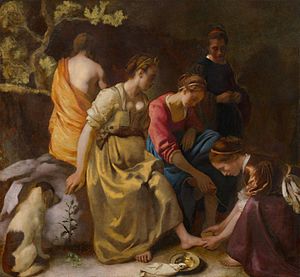Diana and Her Companions
| Diana and Her Companions | |
|---|---|
 |
|
| Artist | Johannes Vermeer |
| Year | 1655–1656 or c. 1653–1654 |
| Medium | Oil on canvas |
| Dimensions | 98.5 cm × 105 cm (38.8 in × 41 in) |
| Location | Mauritshuis, The Hague |
Diana and Her Companions is a painting by Dutch artist Johannes Vermeer completed in the early to mid-1650s, now at the Mauritshuis museum in The Hague. Although the exact year is unknown, the work may be the earliest painting of the artist still extant, with some art historians placing it before Christ in the House of Martha and Mary, some after.
The painting's solemn mood is unusual for a scene depicting the goddess Diana, and the nymph washing the central figure's feet has captured the attention of critics and historians, both for her activity and contemporary clothing. Rather than directly illustrating one of the dramatic moments in well-known episodes from myths about Diana, the scene shows a woman and her attendants quietly at her toilette. The theme of a woman in a private, reflective moment would grow stronger in Vermeer's paintings as his career progressed.
Nothing of the work's history before the mid-19th century is known, and the painting was not widely accepted as one of Vermeer's until the early 20th century, when its similarities with Mary and Martha were noticed. About one ninth of the painting's width has been removed from the right side, and it was not discovered until 1999 or 2000 was that the sky in the upper right-hand corner had been added in the 19th century.
The painting depicts the Greek and Roman goddess Diana ("Artemis" in Ancient Greece) with four of her companions. She wears a loose fitting, yellow dress with an animal-skin sash and, on her head, a diadem with a symbol of the crescent moon. As she sits on a rock, a nymph washes her left foot. Another, behind Diana, sits with her partially bare back to the viewer (the most skin Vermeer shows on a figure in any of his extant paintings), a third nymph, sitting at Diana's left, holds her own left foot with her right hand. A fourth stands in the rear, somewhat apart from the rest of the group and facing them and the viewer at an angle, her eyes cast down, her fists in front of her. A dog sits in the lower left-hand corner near Diana, its back to the viewer as it faces the goddess, her attendants and, immediately in front of it, a thistle.
Except for the woman whose face is completely turned away from the viewer, all of the other faces in the painting are to one degree or another in shadow, including that of the dog. None of the women look at each other, each seemingly absorbed in their own thoughts, a fact which contributes to the solemn mood of the piece.
...
Wikipedia
